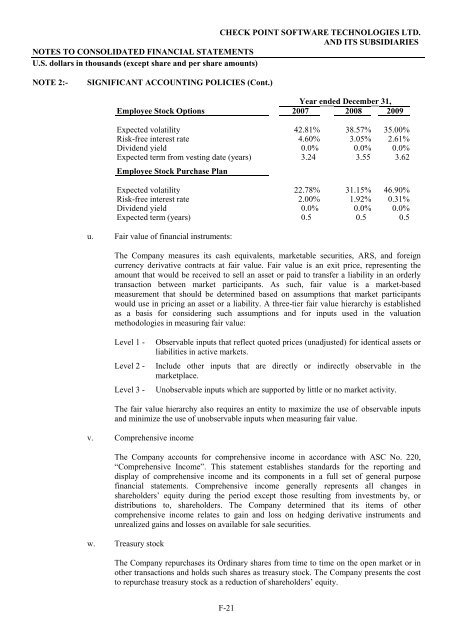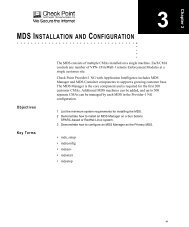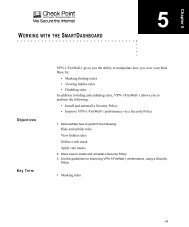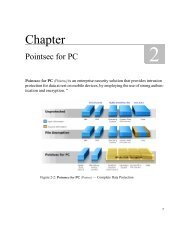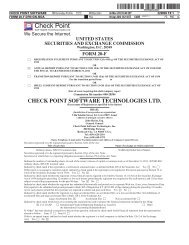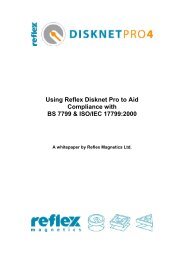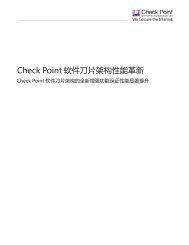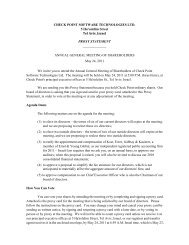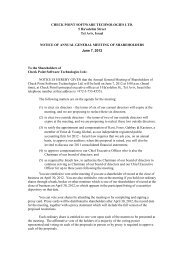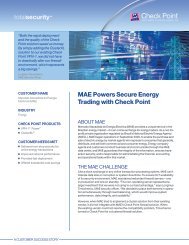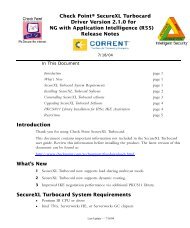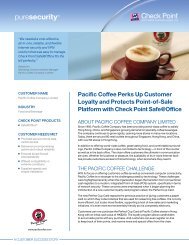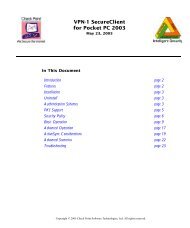FORM 20-F - Check Point
FORM 20-F - Check Point
FORM 20-F - Check Point
Create successful ePaper yourself
Turn your PDF publications into a flip-book with our unique Google optimized e-Paper software.
CHECK POINT SOFTWARE TECHNOLOGIES LTD.<br />
AND ITS SUBSIDIARIES<br />
NOTES TO CONSOLIDATED FINANCIAL STATEMENTS<br />
U.S. dollars in thousands (except share and per share amounts)<br />
NOTE 2:- SIGNIFICANT ACCOUNTING POLICIES (Cont.)<br />
Year ended December 31,<br />
Employee Stock Options <strong>20</strong>07 <strong>20</strong>08 <strong>20</strong>09<br />
Expected volatility 42.81% 38.57% 35.00%<br />
Risk-free interest rate 4.60% 3.05% 2.61%<br />
Dividend yield 0.0% 0.0% 0.0%<br />
Expected term from vesting date (years) 3.24 3.55 3.62<br />
Employee Stock Purchase Plan<br />
Expected volatility 22.78% 31.15% 46.90%<br />
Risk-free interest rate 2.00% 1.92% 0.31%<br />
Dividend yield 0.0% 0.0% 0.0%<br />
Expected term (years) 0.5 0.5 0.5<br />
u. Fair value of financial instruments:<br />
The Company measures its cash equivalents, marketable securities, ARS, and foreign<br />
currency derivative contracts at fair value. Fair value is an exit price, representing the<br />
amount that would be received to sell an asset or paid to transfer a liability in an orderly<br />
transaction between market participants. As such, fair value is a market-based<br />
measurement that should be determined based on assumptions that market participants<br />
would use in pricing an asset or a liability. A three-tier fair value hierarchy is established<br />
as a basis for considering such assumptions and for inputs used in the valuation<br />
methodologies in measuring fair value:<br />
Level 1 - Observable inputs that reflect quoted prices (unadjusted) for identical assets or<br />
liabilities in active markets.<br />
Level 2 - Include other inputs that are directly or indirectly observable in the<br />
marketplace.<br />
Level 3 - Unobservable inputs which are supported by little or no market activity.<br />
The fair value hierarchy also requires an entity to maximize the use of observable inputs<br />
and minimize the use of unobservable inputs when measuring fair value.<br />
v. Comprehensive income<br />
The Company accounts for comprehensive income in accordance with ASC No. 2<strong>20</strong>,<br />
“Comprehensive Income”. This statement establishes standards for the reporting and<br />
display of comprehensive income and its components in a full set of general purpose<br />
financial statements. Comprehensive income generally represents all changes in<br />
shareholders’ equity during the period except those resulting from investments by, or<br />
distributions to, shareholders. The Company determined that its items of other<br />
comprehensive income relates to gain and loss on hedging derivative instruments and<br />
unrealized gains and losses on available for sale securities.<br />
w. Treasury stock<br />
The Company repurchases its Ordinary shares from time to time on the open market or in<br />
other transactions and holds such shares as treasury stock. The Company presents the cost<br />
to repurchase treasury stock as a reduction of shareholders’ equity.<br />
F-21


